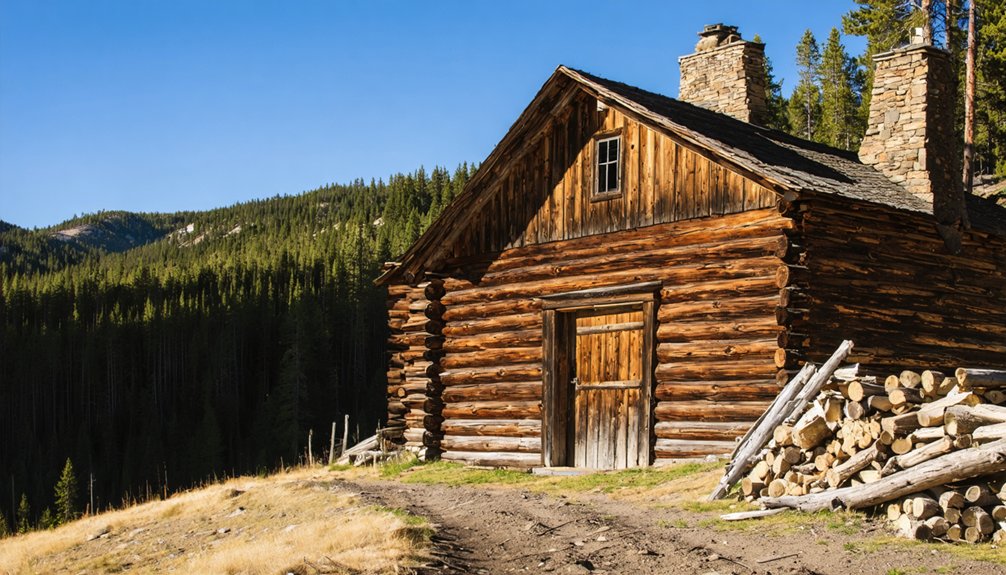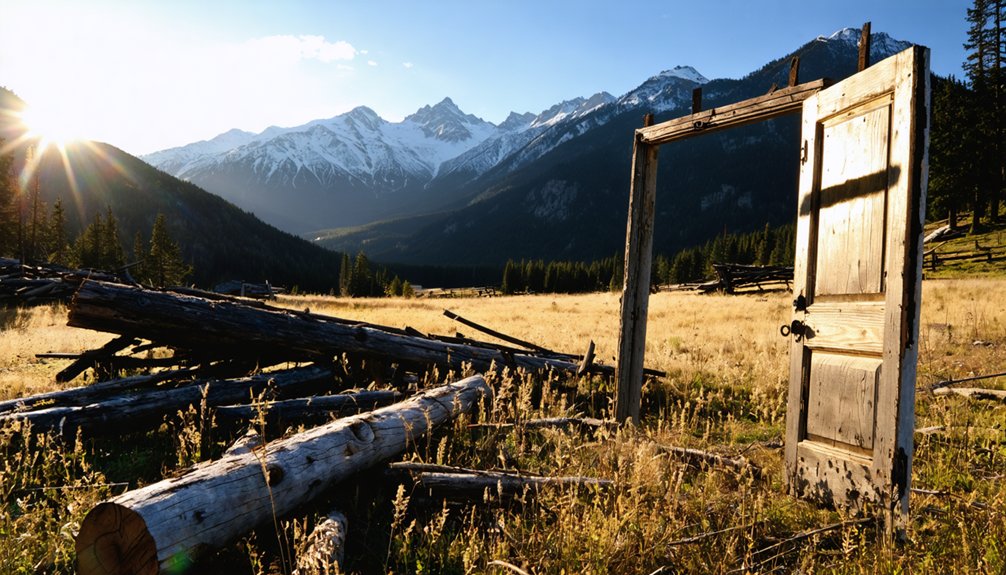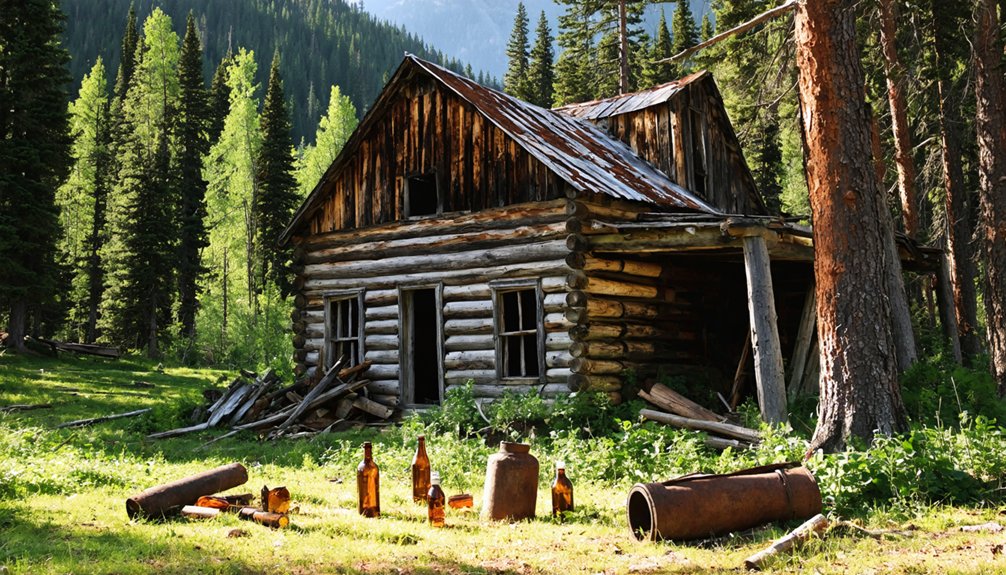You’ll discover Teller City, a remarkably preserved Colorado ghost town, nestled in Roosevelt National Forest. Founded during the 1879 silver boom, this once-thriving settlement housed 1,500 residents and 27 saloons before collapsing after the 1893 Silver Crash. Access requires high-clearance 4WD vehicles for the final miles from Walden. While exploring the weathered cabin foundations and rusting equipment, you can also enjoy hiking, fishing, and camping in the surrounding wilderness. The site’s haunting remnants await.
Key Takeaways
- Teller City was a silver boomtown established in 1879 that reached 1,500 residents before being abandoned by 1902.
- The town’s collapse was triggered by the 1893 Silver Crash when prices dropped from 80 to 60 cents per ounce.
- At its peak, Teller City featured 27 saloons, the Yates House Hotel, and mines producing up to 125 tons of ore daily.
- Located in Jackson County, the ghost town is accessible via County Road 21, requiring 4WD for the final 3 miles.
- Visitors can explore remaining cabin foundations while enjoying nearby hiking, fishing, and camping in Roosevelt National Forest.
The Silver Boom and Founding of Teller City (1879)
The discovery of silver in the mountains of southeast North Park in 1879 catalyzed a transformative period in Colorado’s mining history, precipitating the rapid establishment of Teller City.
Silver’s discovery in North Park’s mountains sparked Colorado’s mining revolution, birthing Teller City almost overnight.
Prospectors swarmed to this remote site near Jack Creek, quickly establishing a foothold in what would later become part of Roosevelt National Forest. The settlement’s nomenclature honored Senator Henry M. Teller, an influential Colorado politician who championed western interests. As an advocate for silver mining, Teller had served as senator from Colorado since the state’s admission in 1876.
Initially part of Grand County before redistricting placed it within Jackson County, the nascent community reflected the characteristic impermanence of frontier settlements.
Early accommodations consisted primarily of hastily constructed cabins and canvas tents. The silver discovery transformed this wilderness into a burgeoning community as miners and entrepreneurs staked their claims, seeking fortune in the mountain’s veins—a reflection of your frontier ancestors’ determination to forge their destiny in Colorado’s unforgiving wilderness. The town quickly grew to become the largest in the region, with its population peaking at over 1500 residents during the height of the silver boom.
Life in a Bustling Mining Settlement
At its peak, you’d find Teller City miners following grueling daily routines, punctuated by visits to the town’s remarkable 27 saloons that served as social hubs where tired workers sought relief from their labors.
Your journey through this silver boomtown would reveal a vibrant economic ecosystem where high-grade ore valued at up to $3,000 per ton initially promised fortune, though profitability diminished as shipping costs to distant smelters ate into margins.
The social landscape reflected typical frontier sensibilities, with the 40-room Yates Hotel anchoring community life alongside establishments of varying respectability that catered to a largely male population seeking diversions from the harsh mountain existence. Similar to other mining communities formed during the gold rush era, Teller City experienced rapid development that transformed the natural landscape into a bustling settlement centered around resource extraction. The town’s fortunes dramatically declined when silver ore quality plummeted to only $20 per ton by 1884, signaling the beginning of the end for this once-thriving community.
Daily Miner Routines
While operating at full capacity during the boom years of 1882-1884, Teller City’s mining operations demanded rigorous daily routines from its chiefly male workforce.
You’d find miners extracting up to 125 tons of ore daily, though the knife-blade thin veins (rarely exceeding one-quarter inch) presented significant extraction challenges.
Miner workdays revolved around three critical activities:
- Laboring at the Endomile Mine, located three miles from town, where the most promising deposits existed
- Bringing extracted materials to processing facilities where the value varied dramatically—from $3,000 per ton initially to merely $20 by 1884
- Maintaining equipment at one of the blacksmith shops, essential for both town operations and mining activities
Daily challenges included the thin, unreliable veins and prohibitively expensive transportation costs to distant smelters, foreshadowing the town’s eventual collapse.
Saloons and Entertainment
Saloons dominated Teller City’s social landscape with an astonishing density of 27 establishments serving a population of barely 1,500 residents at the boom’s peak.
These weren’t merely drinking venues but multifaceted centers of frontier life where you’d find gambling tables, prostitution, and occasional live music performances. The vibrant saloon culture clustered around the imposing Yates House Hotel, creating an entertainment district where miners spent their silver earnings after exhausting shifts.
Beyond drinking, you’d find yourself participating in card games, fishing nearby streams, or gathering at the North Park Miner newspaper office for intellectual discourse. With minimal law enforcement present in the town, these establishments often regulated themselves through informal codes of conduct.
These entertainment venues functioned as economic engines, driving demand for goods and services while fostering essential social connections.
When silver prices collapsed in 1884, these establishments quickly shuttered, revealing their complete dependence on mining prosperity.
Frontier Community Economics
Three distinct economic forces converged to shape Teller City’s frontier economy following the 1879 silver discovery. You’d have witnessed a classic boom-and-bust cycle driven by mineral extraction, transportation constraints, and market forces.
The town’s economic sustainability hinged precariously on silver prices, which catastrophically collapsed in 1884.
Mining profitability faced several structural challenges:
- Thin, scattered ore veins rarely formed substantial deposits
- Prohibitive shipping costs to distant smelters eroded profit margins
- The Treasury’s shift to the gold standard destabilized silver markets
Despite reaching 1,500 residents with a developed infrastructure including sawmills, hotels, and essential services, the economic foundation remained fragile.
When silver prices plummeted, the town couldn’t adapt. By 1887, the population had dwindled to 300, and fifteen years later, nature had reclaimed this once-thriving frontier experiment.
Architectural Remains and Historical Structures
Despite the passage of over a century, Teller City’s architectural footprint remains partially discernible within Colorado’s reclaiming wilderness. The site’s architectural significance is evident in the foundations of larger structures that once comprised this bustling silver town.
Fading yet persistent, Teller City’s structural ghosts whisper architectural histories through Colorado’s advancing wilderness.
During its heyday, the settlement boasted the 40-room Yates Hotel, over two dozen saloons, a post office, newspaper building, and hundreds of temporary cabins.
Today, preservation challenges are manifold as the pine forest steadily reclaims what humans abandoned. Only a few cabins and building foundations withstand nature’s persistent encroachment.
As you walk the three-quarter-mile loop trail, you’ll encounter scattered log cabin remnants, the old schoolhouse ruins, and mine-related structures—silent testimonies to frontier ingenuity and the transient nature of boomtown architecture. The Nature Trail provides informative historical markers that describe the significance of various remaining structures. A self-guided trail leads visitors through the remains and historical artifacts, providing insight into daily life during Teller City’s peak period.
The Great Silver Crash and Town Abandonment

Teller City’s meteoric rise from wilderness outpost to thriving silver boomtown came to an abrupt end during the Great Silver Crash of 1893, a catastrophic economic event that fundamentally altered the American West’s mining landscape.
The economic consequences were swift and devastating—silver prices plummeted from 80 cents to 60 cents per ounce, forcing mines to close overnight and unemployment to skyrocket to nearly 50%.
The social impact on Teller City was equally profound:
- Banks collapsed as panicked residents withdrew their uninsured savings
- Critical services diminished as population fled, accelerating abandonment
- Railroad service reductions further isolated the remaining inhabitants
When Congress repealed the Sherman Silver Purchase Act, adopting the gold standard instead, Teller City’s fate was sealed. The British Parliament’s decision on June 26, 1893 was particularly devastating, triggering the rapid shutdown of American silver operations.
Without economic diversification to buffer against the industry’s collapse, the town rapidly transformed from boom to bust.
The Coinage Act of 1873 had already set the stage for this disaster by disestablishing bimetallism and making gold the monetary standard long before the crash occurred.
How does one reach this remote relic of Colorado’s mining past? Teller City is primarily accessed via County Road 21 from Gould through Roosevelt National Forest, or alternatively from Highway 125 near Rand.
The journey requires traversing about 25 miles south of Walden, followed by a 12-mile drive along the Illinois River after the Old Homestead turnoff.
Be advised that while the initial 7 miles feature smooth dirt access routes, the final 3 miles demand high-clearance 4WD vehicles due to challenging road conditions. The area was once home to 27 saloons during its peak mining days.
The site is only accessible seasonally (mid-April through mid-November), with forest closures during winter months. At 8,200 feet elevation, weather changes rapidly.
Check Forest Service restrictions before departing, as beetle-kill hazards occasionally prompt closures. GPS coordinates (40.4333°N, 106.0034°W) prove invaluable, as cell service is unreliable in this freedom-filled backcountry.
What to See During Your Ghost Town Exploration

Once you’ve successfully navigated the challenging terrain to reach this isolated historical site, a wealth of nineteenth-century artifacts and architectural remnants await your exploration.
The forest-shrouded landscape reveals Teller City’s vibrant past through careful observation. Historical markers along the Nature Trail loop provide essential context about former businesses, homes, and personal narratives that illuminate frontier life.
- Log cabin remnants and foundations of the impressive 40-room Yates Hotel offer architectural insights into settlement patterns.
- Ghost town artifacts including broken crockery, bottles, and mining equipment provide material evidence of daily existence.
- Natural reclamation processes demonstrate how the pine forest has gradually engulfed human structures, creating a dynamic tableau of historical regression.
As you traverse the site, note evidence of the town’s former economic significance—once supporting numerous saloons, a newspaper, and post office during its nineteenth-century apex.
Outdoor Recreation Options Around Teller City
Beyond the historical allure of Teller City’s abandoned structures, the surrounding Roosevelt National Forest offers a diverse array of outdoor recreational pursuits that complement ghost town exploration.
You’ll discover extensive hiking trails for all ability levels, from the scenic Jack Creek Trail to the gentler Lily Lake loop, each connecting historical mining relics with natural splendor.
Fishing spots abound in nearby lakes and streams, particularly during summer months when cold-water species thrive in accessible waterways.
For those seeking more adventurous terrain, designated OHV routes including the challenging Teller Divide and Calamity Pass accommodate everything from ATVs to high-clearance 4×4 vehicles.
Dispersed camping opportunities exist throughout the forest (though not within historic boundaries), allowing you to extend your wilderness experience while adhering to preservation guidelines and Leave No Trace principles.
Photography Tips for Capturing a Colorado Ghost Town

Teller City’s crumbling structures and abandoned artifacts present exceptional photographic opportunities for those who understand how to capture their historical essence through thoughtful composition and technical skill.
When documenting this forgotten mining settlement, ideal timing greatly impacts image quality—arrive during golden hour when soft light bathes weathered wood in amber glow, or during overcast conditions for even illumination of architectural details.
- Employ wide-angle lenses (16-35mm) for contextual shots of building relationships and spatial dynamics, while telephoto options (70-200mm) isolate compelling details like hand-forged nails or weathered signage.
- Stabilize your equipment with a tripod when capturing long exposures of interiors or moonlit composition strategies.
- Consider black and white conversion to emphasize textural contrasts in decomposing structures, focusing viewer attention on form rather than color.
Frequently Asked Questions
Were Any Famous Outlaws or Gunfights Documented in Teller City?
Despite Teller City’s 1,200 peak residents and numerous saloons, no famous outlaws or documented gunfights are attributed specifically to Teller City, though the broader region experienced typical mining-era lawlessness you’d expect.
Can Artifacts Be Legally Collected From the Ghost Town Site?
No, you can’t legally collect artifacts from ghost town sites. Federal and state legal regulations prohibit unauthorized collection, emphasizing artifact preservation on public lands regardless of your freedom-oriented perspective.
Are There Any Paranormal or Haunting Reports From Teller City?
You’ll find no credible paranormal reports or ghost sightings from Teller City. Unlike other documented haunted locations, this ghost town’s reputation stems from historical abandonment rather than supernatural phenomena.
What Wildlife Hazards Should Visitors Be Aware Of?
Like Goldilocks wandering into bear territory, you’ll need wildlife safety vigilance. Black bears, mountain lions, and moose present significant hazards. Practice proper food storage, maintain awareness, and carry bear spray when exploring.
Did Any Indigenous Peoples Occupy the Area Before Mining Began?
Yes, you’ll find significant Indigenous history in the area. Ute tribes occupied North Park seasonally, hunting buffalo and deer while considering the region their sacred territory before mining operations began.
References
- https://www.uncovercolorado.com/ghost-towns/teller-city/
- https://www.ghosttowns.com/states/co/tellercity.html
- https://www.visitnorthparkco.com/ghost-towns-of-jackson-county/
- https://janmackellcollins.wordpress.com/2018/09/06/lost-ghost-towns-of-teller-county-colorado-introduction/
- https://stories.grandcountyhistory.org/article/teller-city-crescent-city-and-tyner
- https://www.youtube.com/watch?v=HFmHLwJr7o4
- http://coloradosghosttowns.com/Teller City Colorado.html
- https://www.coloradolifemagazine.com/blog/post/colorado-mining-history
- https://www.fs.usda.gov/media/69273
- https://digital.denverlibrary.org/nodes/view/1024348



